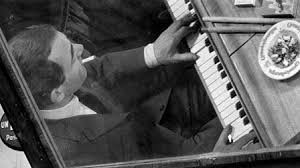là-bas
by
Douglas Messerli
François
Truffaut (screenwriter and director, based loosely on a novel by David Goodis) Tirez
sur le pianist (Shoot the Piano Player) / 1960, USA 1964
François Truffaut’s Shoot the Piano Player is so many things
that it is difficult to know where to begin in describing it. Charlie Kohler
(Charles Aznavour) is a down-and-out wreck of a human being, playing a kind of
hurdy-gurdy sounding jazz piano in a French dive, where prostitutes flirt with
customers as they dance. One of the local prostitutes, Clarisse (Michèle
Mercier), also a neighbor, offers her services to the sad-sack Charlie for
free. Charlie’s true love, however, is the bar’s waitress, Léna (Marie DuBois),
with whom he soon shyly develops a relationship. Accordingly, it appears, on
the surface at least, that the film is a kind of sad love story.
When Chico appears at the
bar where Charlie works, the piano-player is suddenly involved in the so-called
“family business,” and is also threatened by the chasing mobsters; and so too,
through their association with Charlie, are Léna and Charlie’s younger brother,
Fido, who lives with him. Much of the rest of the movie plays out as a gangster
story.
On top of this, Truffaut
also layers another genre, introducing a comic singer in the bar, Bobby
Lapointe, whose bawdy lyrics are sung so quickly that they become hard to
understand in French, that Truffaut comically reproduced them in writing
replete with a bouncing ball. Later, when the mobsters kidnap Fido, the boy
outwits their antic Keystone Kops behavior, reminding one almost of the O.
Henry story “The Ransom of Red Chief.” And throughout this film, the director
stirs up his Mulligan stew with large doses of farce.
Truffaut salts these
elements with long and shorter disquisitions on the nature of women, both by
the course-minded mobsters and Charlie himself: “Once you have met one you have
met them all,” as well as New Wave-like discussions on other subjects,
suggesting that the film might shift into the realm of a dialogue, which was so
central to Godard’s Breathless of the same year.
Yet for all that, over time Shoot the Piano Player has held up as a lovingly energetic valentine of American grade B-movies. I’d go even farther by describing it as a loving tribute to American culture at large. Loosely based on a novel by American writer David Goodis, Down There, this film is a kind of là-bas (“over there” or “down-there”) view of the warring contradictions—at least from a Frenchman’s view—of US life, where “over there” is perhaps also a kind of hell—but nonetheless kinetic world that in its very diversity breaks with the bonds of the past.
Truffaut himself saw the
film as a purposeful attempt “to break the linear narrative and make a film
where all the scenes would please me. I shot without any other criteria.” The
result is an energetic, at times almost frenetic fantasia, a work that is
a-jumble—as life often is—with comedy, tragedy, and ridiculous melodrama.
Charlie’s world, like Chaplin’s world, is one in which the ordinary clown of
everyday life is doomed to fall over and over, who yet, like a Beckettian
figure, miraculously goes on, rising again to perform, to enact his lowly art.
Yes, Charlie is a bastard, a fool, a lousy lover; but he is also a dreamer, a
romancer who might have been a Casanova if he’d only had a break.
Los
Angeles, January 25, 2014
Reprinted from World Cinema Review (January 2014).







No comments:
Post a Comment